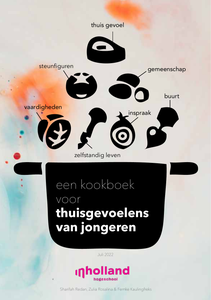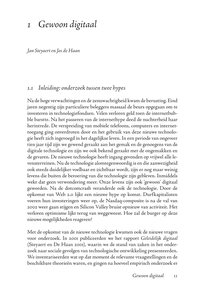Grenzen zijn binnen onderwijs en opvoeding een klassiek thema. Maar waar enerzijds een roep is om meer en hardere (opvoedings)grenzen, voelen we anderzijds ook een verlegenheid bij het stellen van die grenzen. Waar komt dat ongemak vandaan en hoe gaan we ermee om? Hoogleraar Maatschappelijke Opvoedingsvraagstukken Micha de Winter beantwoordt zeven vragen over het vraagstuk
LINK
BackgroundA key factor in successfully preventing falls, is early identification of elderly with a high risk of falling. However, currently there is no easy-to-use pre-screening tool available; current tools are either not discriminative, time-consuming and/or costly. This pilot investigates the feasibility of developing an automatic gait-screening method by using a low-cost optical sensor and machinelearning algorithms to automatically detect features and classify gait patterns.MethodParticipants (n = 204, age 27 ± 7 yrs.) performed a gait test under two conditions: control and with distorted depth perception (induced by wearing special goggles). Each test consisted of 4x 3m walking at comfortable speed. Full-body 3D kinematics were captured using an optical sensor (Microsoft Xbox One Kinect). Tests were conducted in a public space to establish relatively 'natural' conditions. Data was processed in Matlab and common spatiotemporal variables were calculated per gait section. The 3D-time series data of the centre of mass for each section was used as input for a neural network, that was trained to discriminate between the two conditions.ResultsWearing the goggles affected the gait pattern significantly: gait velocity and step length decreased, and lateral sway increased compared to the control condition. A 2-layer neural network could correctly classify 79% of the gait segments (i.e. with or without distorted vision).ConclusionsThe results show that gait patterns of healthy people with distorted vision could automatically be classified with the proposed approach. Future work will focus on adapting this model for identification of specific physical risk-factors in elderly.
DOCUMENT

In recent years video game consoles, such as the Nintendo Wii™ and the Microsoft Kinect™, have been introduced into residential facilities. This paper presents a review of current studies documenting the benefits and detriments the Wii could have on adults aged 60 years and over in residential facilities, concentrating on the common uses of the Wii in care facilities: maintaining physical fitness, promoting mental well-being, encouraging social interaction and both physical and mental rehabilitation. Furthermore, this paper discusses the potential use of the Microsoft Kinect in care for older persons. The Wii can have a positive impact on the physical and mental health of older adults living in care facilities, but additional work should still be conducted, including assessing the use of games outside of Wii Sports and Wii Fit and possible non-gaming application of the Wii in care for older adults. Results for the Wii display potential for use of the Kinect in care facilities but further exploration is required to assess the potential physical impact and interaction viability.
DOCUMENT

In dit kookboek nemen we je mee in het ‘koken’ van een thuisgevoel. Dit kookboek is gericht op professionals die met jongvolwassenen werken en professionals die zich bezig houden met woonvormen gericht op jongvolwassenen. Elk recept bestaat uit een aantal elementen: – Een uitleg waarin we het recept toelichten – De hoofdingrediënten die we illustreren met uitspraken en ervaringen – Praktische TIPS zodat je dit recept direct kunt ‘koken’ – In sommige recepten vind je ook smaakmakers. Dit zijn tips of aandachtspunten die het recept naar een hoger niveau tillen
DOCUMENT

Steeds meer ouderen lijken te worstelen met de integratie van twee aparte werelden, de echte en de virtuele, want zij zien de voordelen van nieuwe communicatiemiddelen en willen de aansluiting met de moderne wereld niet missen. Hedendaagse jongeren staan anders in het leven: voor hen is er maar één wereld. Technologie is zo vanzelfsprekend dat ze helemaal niet meer zien waar ICT een rol speelt en waar niet. Het is er ‘gewoon’ en als het leuk of nuttig is moet je het gebruiken. Het internet en mobiele apparaten zijn alleen maar hulpmiddelen om je zo goed mogelijk te informeren, om te communiceren, te netwerken en je te vermaken.
DOCUMENT

Nederlanders zijn gewoon digitaal Jaarboek ICT en samenleving 2007: Gewoon digitaal. Gewoner en intensiever gebruik van nieuwe media Internetgebruik van hoogopgeleiden is veelzijdiger en productiever dan van laagopgeleiden. Meer ouderen online, maar achterstand blijft groot. Belang van internet als informatiebron groeit Meer overheidsinformatie online Gebruik online gezondheidsinformatie stijgt Nederland is koploper met telewerken. ICT leidt niet tot meer werkdruk, maakt het werk wel interessanter Dit zijn de belangrijkste conclusies uit het vijfde Jaarboek ICT en samenleving: Gewoon dgitaal, dat op dinsdag 12 mei a.s. wordt aangeboden aan de Alexander Rinnooy Kan, voorzitter dan de SER. Het Jaarboek, dat verschijnt bij uitgeverij Boom, is een samenwerkingsproject van het Sociaal en Cultureel Planbureau (SCP), Fontys Hogescholen en het programma 'Maatschappij en de Elektronische Snelweg' van de Nederlandse Organisatie voor Wetenschappelijk Onderzoek (NWO-MES). Onder redactie van prof. dr Jan Steyaert (Fontys Hogescholen) en prof. dr Jos de Haan (SCP) gaan vooraanstaande wetenschappelijke onderzoekers nader in op de gevolgen van internet voor de samenleving. Gewoner en intensiever gebruik van nieuwe Het aandeel van de Nederlandse bevolking met thuis toegang tot internet steeg van 16% in 1998 naar 78% in 2005. Naast toenemende toegang is er sprake van intensiever gebruik, met tussen 2000 en 2005 meer dan een verdubbeling van de tijdsbesteding aan internet (van gemiddeld 1.8 naar 3.8 uur per week). Bovendien worden burgers steeds meer informatieproducent (via weblogs e.d.) naast de meer traditionele rol van informatieconsument. Gevarieerd internetgebruik van hoogopgeleiden Hoogopgeleiden gebruiken meer verschillende internettoepassingen dan laag opgeleiden. Bovendien gebruiken zij meer informatieve en zakelijke toepassingen, zoals actualiteit en nieuws, informatie over werk en vacatures, internet-bankieren, het online kopen en verkopen van goederen en het gebruik van overheidssites, dan laagopgeleiden. Lager opgeleiden gebruiken meer vermaakstoepassingen van het internet in het algemeen, en spelletjes, muziekuitwisseling en chatten in het bijzonder dan hoger opgeleiden. Meer ouderen online In 2005 was 78% van de bevolking met internet verbonden. Het aantal aansluitingen in de groep 55-64 jarigen ligt iets lager op 72%, de 65-74 volgen op grotere afstand (44%) en 75-plussers nog weer minder online (17%). Ook onder deze groepen is de verspreiding langzaam maar zeker toegenomen. In 2000 was namelijk 44% van de bevolking op internet aangesloten (55-64 jarigen: 31%; 65-74 jarigen 12% en 75-plussers 4%. Veel ouderen vinden zichzelf 'te oud' om te leren omgaan met ict. Ook veel ouderen geven aan dat de computer en internet te moeilijk zijn, of ze zien het voordeel of nut er niet van in. Ook financiële of fysieke beperkingen zoals een slecht zicht vormen voor sommige ouderen een belemmering. De veelvuldige verwijzingen naar internet in het dagelijks leven zijn soms een stimulans om internet uit te proberen, maar bij anderen juist aanleiding om te volharden in niet-gebruik. Een positieve grondhouding is van belang om verbinding te maken met internet. Internet belangrijker als informatiebron Steeds meer Nederlanders gebruiken internet om zich te informeren over uiteenlopende onderwerpen. In 2005 gebruikte 38% van de Nederlanders internet voor 17 gespecificeerde onderwerpen. Vijf jaar eerder was dat nog 23%. In 2005 was de televisie nog steeds veruit favoriet (92%) en ook het dagblad blijft populair (77%). Internet is na radio (47%) al wel teletekst (23%) en de opiniebladen (15%) voorbij gestreefd als infomatiebron. Meer overheidsinformatie online Steeds meer gemeenten bieden informatie (bekendmakingen, vergunningen, verordeningen en plannen) on line aan. Zo ontsloot in 2003 26% van de gemeenten een bestuursinformatiesysteem op de website, in 2005 was dit 79%. Gebruik online gezondheidsinformatie stijgt Het aanbieden en zoeken van gezondheidsinformatie via internet neemt aan belang toe. Centraal daarin staat een verwachting dat de patiënt beter geinformeerd is en een betere gesprekspartner is voor (huis)artsen. Nu toegang tot internet 'gewoner' is geworden, worden informatievaardigheden belangrijker, zoals het kunnen beoordelen van informatie op kwaliteit en relevantie. Nederland is koploper met telewerken. Nederland is met ongeveer 20% van de beroepsbevolking die met enige regelmaat thuiswerkt internationaal koploper telethuiswerken. Hoewel telewerken mogelijkheden biedt om arbeid en zorg gemakkelijker te kunnen combineren, wordt het zelden gebruikt als bewuste en structurele strategie om dit ook te doen. Het wordt eerder gebruikt als crisis¬management om tijdnood in het werk het hoofd te bieden. Het werk wordt interessanter door ICT Over de huidige invloed van ICT zijn werkenden van oordeel dat het werk er interessanter door is geworden. Ook vinden zij dat het leven door ict minder ingewikkeld is geworden. Werkenden zijn niet van mening dat zij door ict meer vrije tijd hebben gekregen of dat het tot minder werkdruk heeft geleid. Werkenden hebben wel positieve toekomstverwachtingen van de inzet van ICT. In hun ogen zal ICT in de toekomst in lichte mate bijdragen aan een aangenamer en overzichtelijker leven. Inhoud Jaarboek ICT en samenleving 2007: Gewoon Digitaal 1 Gewoon digitaal Jan Steyaert en Jos de Haan 2 De e-surfende burger: is de digitale kloof gedicht? Jan A.G.M. van Dijk 3 Senioren en internet: aansluiting of kortsluiting? Marion Duimel 4 De digitalisering van media- en informatiegebruik Jos de Haan en Frank Huysmans 5 E-werkenden in netwerken Erik Andriessen en Lambert van der Laan 6 ICT en arbeid: over de verwachtingen van tijdwinst, tijdsoevereiniteit en leuker werk Jelle Attema, Koen Breedveld, Andries van den Broek, Pascale Peters 7 Van gemeenschap via webnetwerk naar datawolk Marianne van den Boomen 8 Op zoek naar de e-democratische burger Arthur Edwards 9 De e-lerende burger Peter Sloep en Wim Jochems 10 ICT en de gezondheidzorg. Samantha A. Adams en Cécile R.L .Boot
DOCUMENT

This book – Complexity and Territorial Development – tells the story of how academic staff and students at the Van Hall Larenstein university of applied sciences deal with complexity and planning in education and research. It is intended for everyone who is involved in complex projects, but in particular for current and future students at the university who will be trained in how to handle complex projects. In this book we want to show why planning has become complex, what theories about this subject are relevant, and how this fits in with the practical experience of staff and students.
DOCUMENT

The objective of this study was to determine if a 3-dimensional computer vision automatic locomotion scoring (3D-ALS) method was able to outperform human observers for classifying cows as lame or nonlame and for detecting cows affected and nonaffected by specific type(s) of hoof lesion. Data collection was carried out in 2 experimental sessions (5 months apart).
MULTIFILE